Did you know that caviar, often referred to as “black gold,” is one of the world’s most luxurious foods? Its reputation is not just about its high price tag but also its intriguing taste that food enthusiasts around the globe rave about.
Caviar’s taste is a fascinating blend of flavors that’s slightly salty, buttery, and reminiscent of the sea. It’s not overly fishy; rather, it carries the essence of the ocean in each tiny, glistening bead.
This might sound a bit abstract if you’ve never tried caviar but don’t worry. I’m here to help you understand what makes this delicacy so special. This article explores its taste, texture and how to best enjoy it.
How Does Caviar Taste?
Imagine this: you’re about to try caviar for the first time. As you place a small spoonful of these glossy pearls on your tongue, you’re immediately greeted by a hint of saltiness.

This isn’t the harsh saltiness of table salt but rather a gentle, sea-like brininess that whisks you away to the ocean’s edge. It’s an initial burst of flavor that sets the stage for the complex symphony of tastes about to unfold.
Now, as the caviar beads burst in your mouth, a rich, buttery flavor starts to emerge. This is where the magic of caviar truly lies.
The buttery taste is smooth and comforting, enveloping your palate in a velvety richness that’s hard to describe. It’s like a warm, savory blanket that wraps your taste buds in a cocoon of culinary delight.
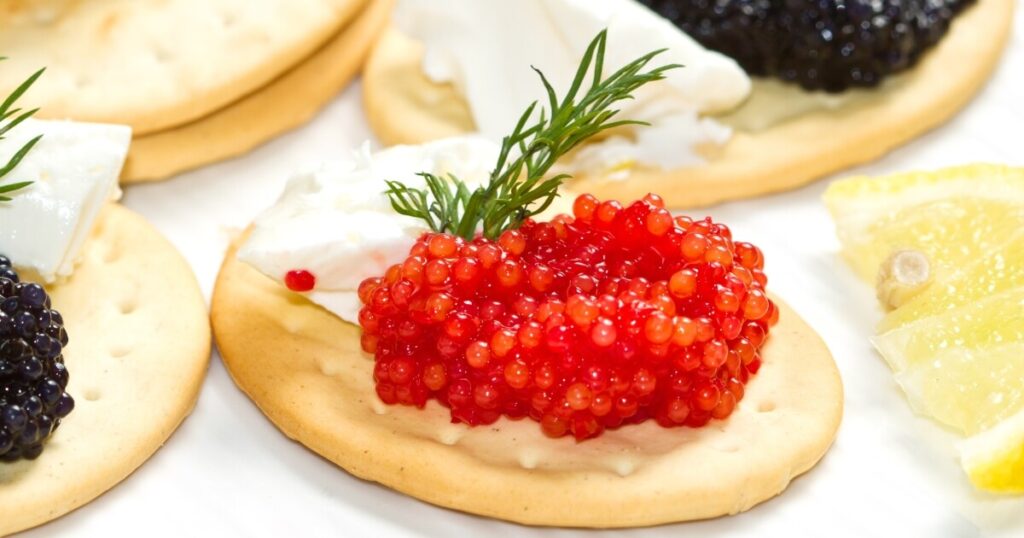
But wait, there’s more. As the buttery flavor starts to fade, you begin to notice a subtle nuttiness.
This pleasant surprise adds a layer of complexity to the caviar’s flavor profile. It’s a gentle whisper of earthiness that balances out the initial saltiness and the rich, buttery taste.
Let’s not forget about the texture, which is crucial to the overall taste experience.
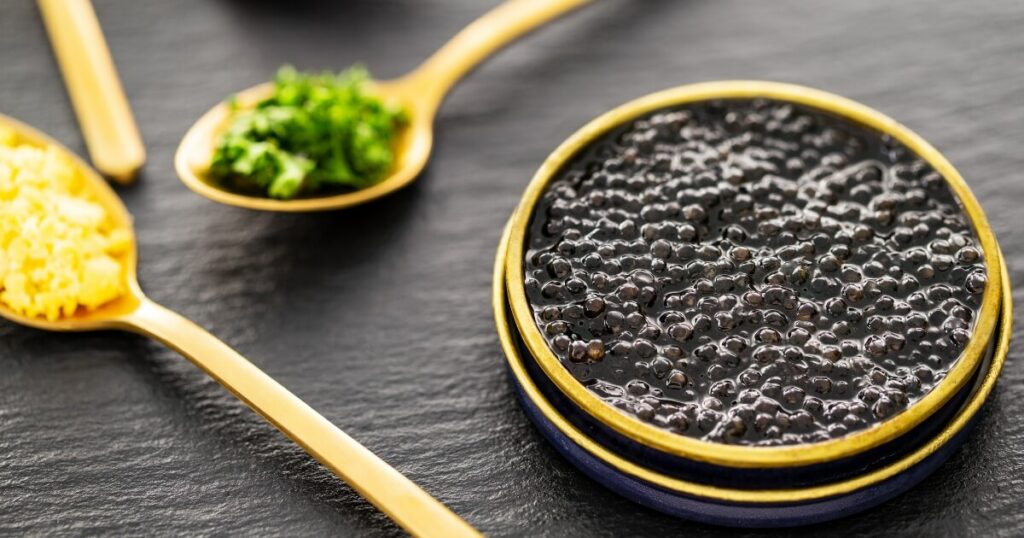
Caviar has a unique texture that’s unlike any other food. The eggs are firm yet delicate, providing a satisfying pop when you bite into them.
This adds a fun element to the eating experience and enhances the release of the flavors, making each bite a burst of sea-infused delight. The texture of caviar is truly a sensory experience that complements its multifaceted taste beautifully.
Varieties Of Edible Caviar
Different types of caviar can have slightly different flavor profiles. Here are a few notable varieties:
- Beluga Caviar: Known as the king of caviar, Beluga has a creamy, buttery flavor that is smooth and rich. It also has a slightly sweet aftertaste.
- Osetra Caviar: This variety is known for its nutty flavor balanced with a hint of sweetness. It’s less buttery than Beluga but equally delicious.
- Sevruga Caviar: Sevruga has a more pronounced sea-like flavor compared to other varieties. It’s slightly salty with a hint of seaweed and a touch of creaminess.
- Sterlet Caviar: This type of caviar is fruity and nutty. It’s less salty than other varieties and has a delicate, refined taste.
What Does Caviar Compare With?
While caviar can be compared to a few other foods in terms of flavor and texture:
- Oysters: Like caviar, oysters have a briny, sea-like flavor. They also have a similar texture, with a firm yet delicate feel.
- Salmon Roe: Salmon roe, or ikura, is often used as a more affordable alternative to caviar. It has a similar pop-in-your-mouth texture but has a stronger, more pronounced fishy flavor.
- Truffles: In terms of luxury and complexity of flavor, truffles can be compared to caviar. They both have a rich, earthy flavor that food enthusiasts highly prize.
- Sea Urchin: Sea urchin, or uni, has a creamy texture and a sweet, briny flavor that can be somewhat similar to caviar. However, uni has a more pronounced sweetness and a softer texture.
Does Caviar Taste Fishy?
The short answer is no, and caviar does not have an overpowering fishy taste. Instead, it has a subtle sea-like flavor that is more like fresh seafood than anything else.
That being said, caviar comes from fish, so its flavor has a slight hint of fishiness. However, this is balanced out by the other flavors present in caviar, such as its buttery richness and a slight nuttiness.

So, while you might notice a hint of fishiness, it’s not the dominant flavor.
If you’re worried about caviar tasting too fishy, you can do a few things.
First, make sure you’re buying high-quality caviar. Lower-quality caviar can often have a stronger fishy taste. Second, try serving your caviar with accompaniments like crème fraîche or lemon, which can help balance out any fishiness.
Does Caviar Smell Fishy?
Just like its taste, the smell of caviar is not overly fishy. Instead, it has a fresh, ocean-like aroma that complements its taste.
The smell of caviar can often give you a hint about its quality. High-quality caviar should smell fresh and clean, like the sea. If the caviar has a strong, unpleasant fishy smell, it might be a sign that it’s not of the best quality or that it’s not fresh.
What Does Caviar Look Like?
Each bead of caviar is small and round, similar in size to a pearl. They have a beautiful, glossy sheen that makes them glisten, adding to their allure.
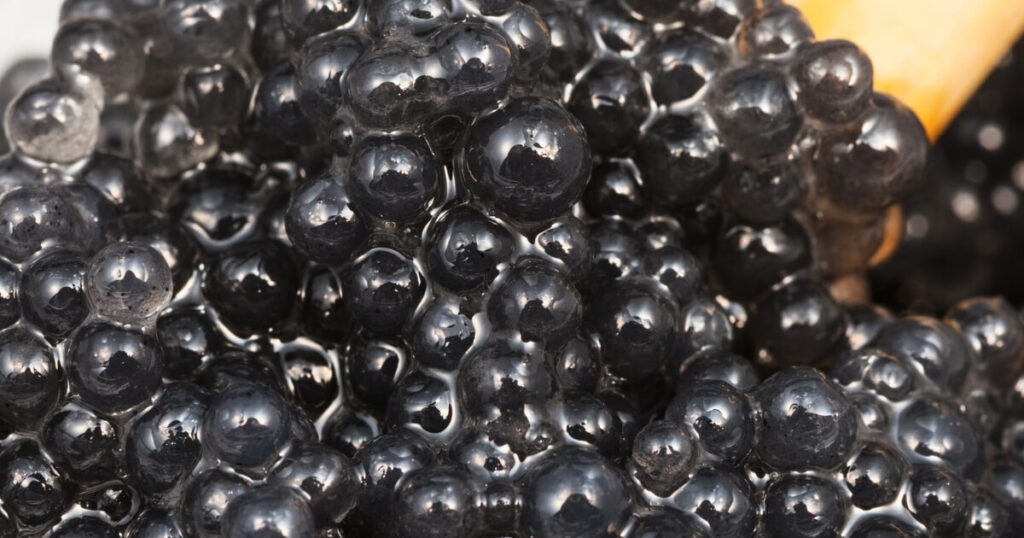
The color of caviar can vary depending on the type of fish it comes from. It can range from light golden hues to deep, dark black.
For instance, Beluga caviar is famous for its large, silvery-gray beads, while Sevruga caviar tends to be smaller and darker in color.
How To Eat Caviar
Eating caviar is an experience that goes beyond just the taste. It’s about the presentation, the accompaniments, and the method of eating. Here’s a basic guide on how to eat caviar to fully appreciate its flavor and texture.
Traditional Method

Traditionally, caviar is served independently to allow the complex flavors to shine through. It’s often presented on a bed of crushed ice in a special caviar dish, accompanied by a mother-of-pearl spoon.
The use of a non-metal spoon is important as metal can alter the taste of the caviar. You can enjoy the caviar directly from the spoon, letting the beads burst in your mouth to release their flavor.
With Accompaniments
While purists might prefer to eat caviar on its own, it can also be enjoyed with a variety of accompaniments. These can help balance the rich, salty flavor of the caviar.
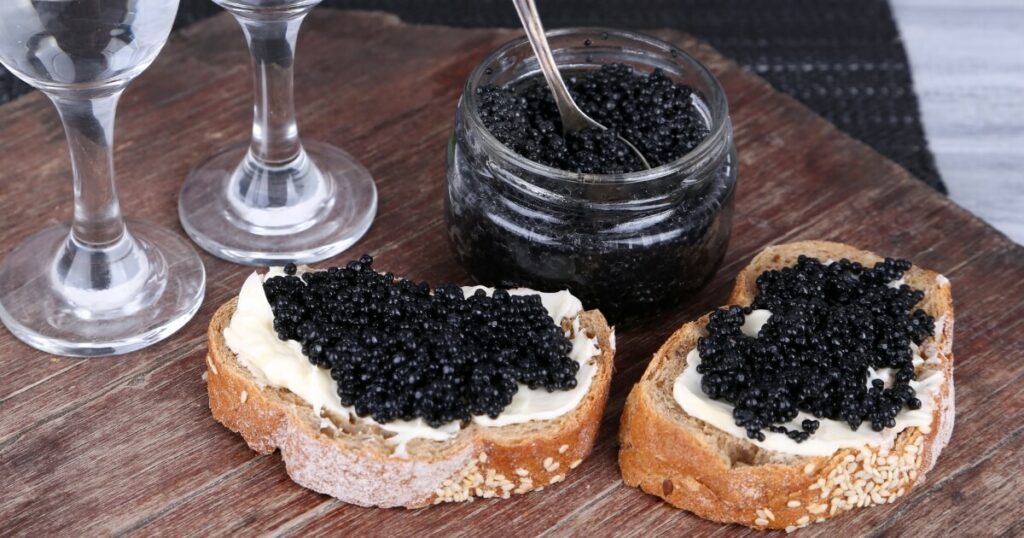
Common accompaniments include blinis (small Russian pancakes), toast points, crème fraîche, chopped hard-boiled eggs, or thinly sliced onions.
The caviar can be placed on top of these accompaniments for a delightful combination of flavors and textures.
In Recipes
Caviar can also be used as a gourmet ingredient in various recipes. It can be used to top canapés, garnish seafood dishes, or even be mixed into pasta for a luxurious twist.
However, it’s important to note that caviar should never be cooked, as heat can ruin its delicate flavor and texture. It should always be added to the dish just before serving.
Paired with Drinks
Finally, caviar is often paired with certain drinks to enhance its flavor. Chilled vodka is a traditional choice, as its clean, crisp flavor complements the caviar beautifully.
Alternatively, champagne is another popular choice, with its bubbles and acidity contrasting the rich, salty caviar.
How To Make Caviar Taste Good
While caviar is a delicacy that is delicious on its own, a few tips and tricks can enhance its taste even further.
Serve It Cold
Caviar should always be served chilled. This helps to preserve its delicate flavor and texture. Before serving, place the caviar in the coldest part of your refrigerator, or serve it on a bed of crushed ice.
Use the Right Utensils
Avoid using metal spoons to serve caviar, as they can impart a metallic taste. Instead, opt for mother-of-pearl, bone, or even plastic spoons. These materials won’t interfere with the taste of the caviar.
Pair It Well
The right accompaniments can enhance the taste of caviar. Consider serving it with blinis, toast points, or boiled eggs. These foods provide a neutral base that allows the flavor of the caviar to shine.
Choose the Right Drink
Pairing caviar with the right drink can also enhance its flavor. Traditional choices include chilled vodka or champagne. The clean, crisp flavors of these drinks complement the rich, salty taste of the caviar.
Quality Matters
Finally, the quality of the caviar can greatly influence its taste. Always buy caviar from a reputable source to ensure you get a high-quality product. Fresh, high-quality caviar will always taste better than a lower-quality alternative.
How To Buy Caviar
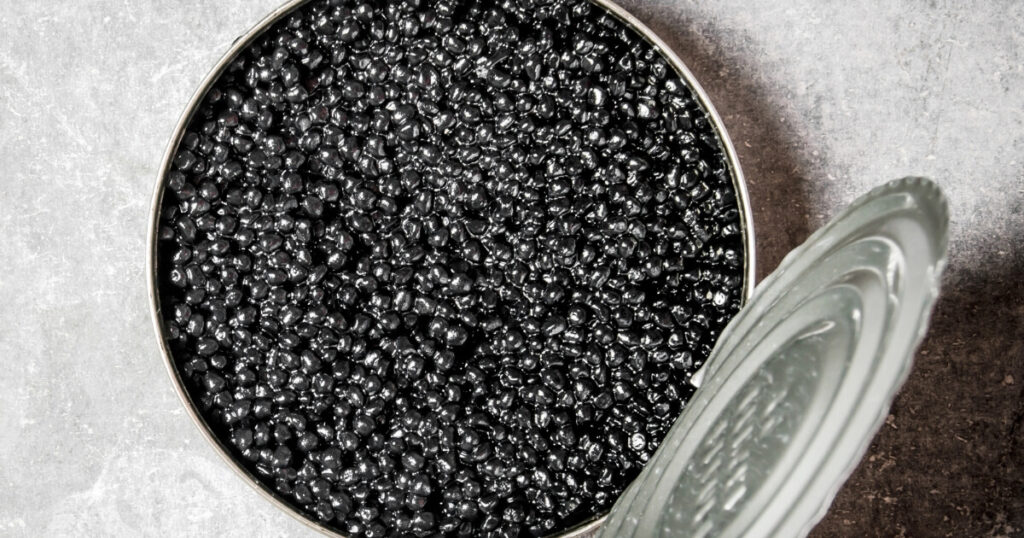
Here’s what you need to know:
Look for Freshness
Freshness is key when buying caviar. Look for caviar that is well-sealed and properly refrigerated. The caviar should have a glossy sheen, and the beads should be firm and intact.
Avoid caviar that looks dried out or has a strong, fishy smell, as this could indicate that it’s not fresh.
Check the Ingredients
High-quality caviar should have minimal ingredients. The ingredients list should include the type of fish, roe, and salt. Avoid caviar that contains preservatives or artificial colors, as these can affect the taste and quality of the caviar.
Consider the Type of Caviar
There are many types of caviar, each with its flavor profile and price point. Beluga, Osetra, and Sevruga are considered the finest types of caviar, but they can be quite expensive. Other types of caviar, like salmon roe or lumpfish roe, can be more affordable and still offer a delightful taste experience.
Buy from a Reputable Source
Always buy caviar from a reputable source. This could be a high-end grocery store, a specialty food store, or a trusted online retailer. These sources are more likely to carry high-quality caviar and store it properly to maintain its freshness.
Consider the Price
Caviar is a luxury item, and its price reflects that. However, the price can also be an indicator of quality. While you don’t need to buy the most expensive caviar, be wary of caviar that is significantly cheaper than average, as it may be of lower quality.


